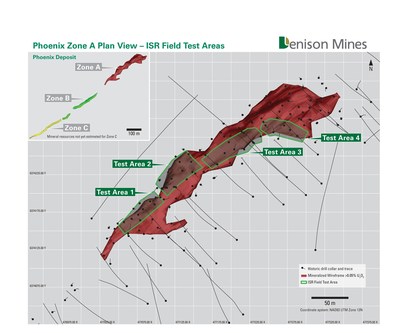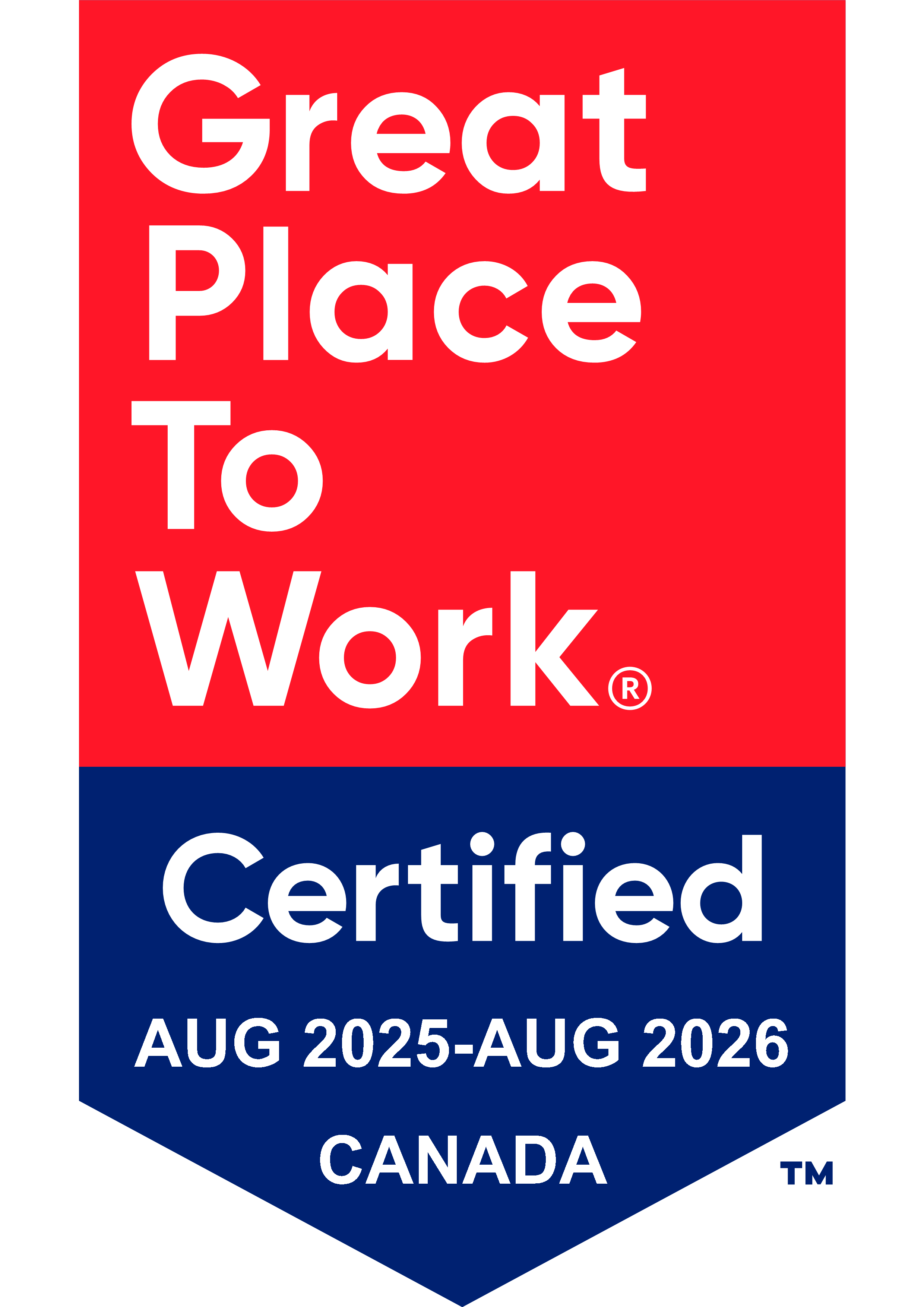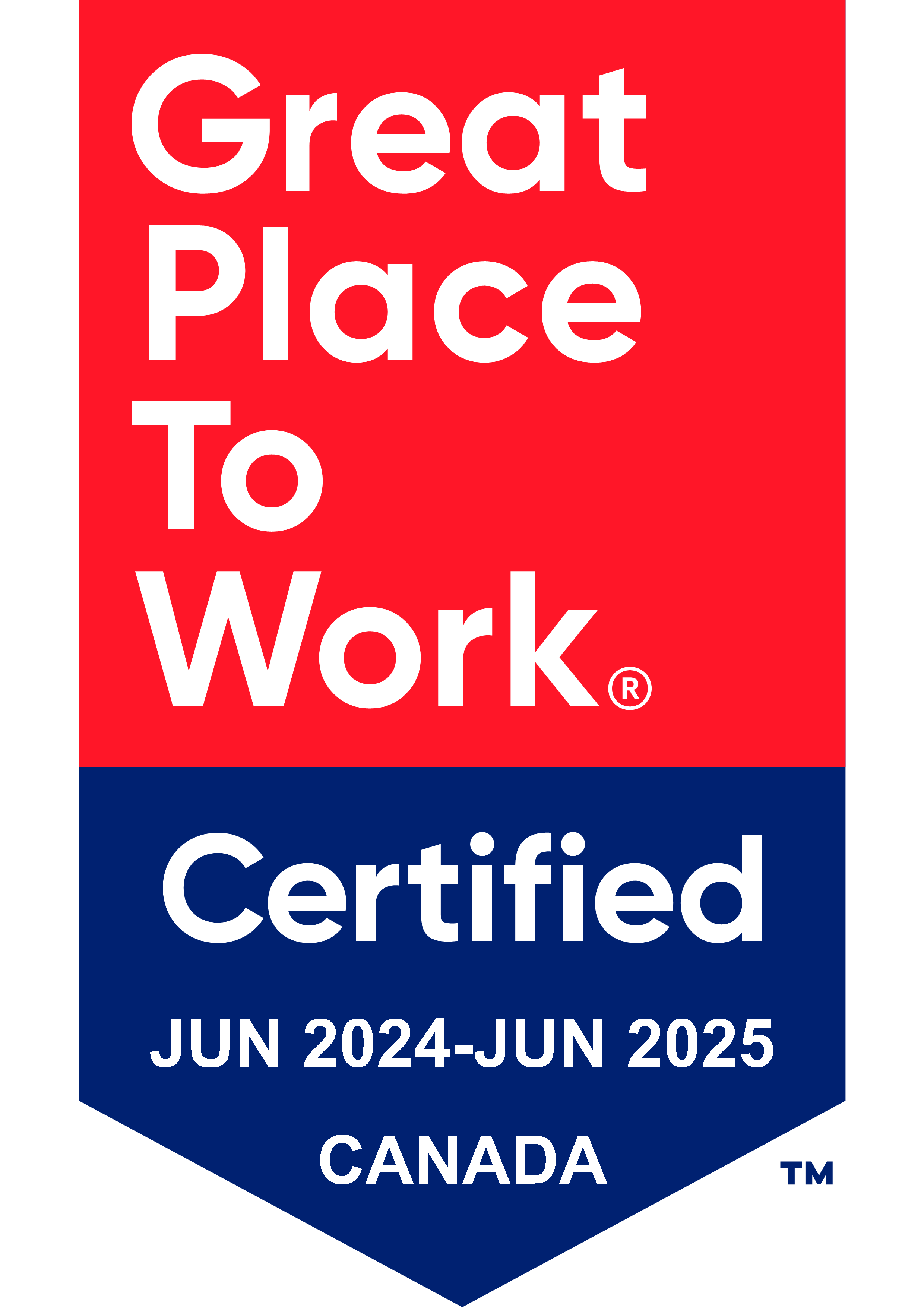News
Denison Reports Initial Results from ISR Field Test at Phoenix Test Area 2 and Advancement to Commercial Scale Wells

TORONTO, Sept. 19, 2019 /CNW/ - Denison Mines Corp. ("Denison" or the "Company") (DML: TSX, DNN: NYSE American) is pleased to announce that the initial In-Situ Recovery ("ISR") field test results from Test Area 2 of the Phoenix deposit ("Phoenix") have confirmed hydraulic connectivity within a significant portion of the ore zone tested. The initial field tests are part of the ongoing ISR field test program at the Company's 90% owned Wheeler River Uranium Project ("Wheeler River") in northern Saskatchewan, Canada.
Following the positive initial test results from Test Area 1 (outlined in Denison's press release dated August 27, 2019) and Test Area 2 (summarized below), Denison has decided to advance to the second stage of ISR field testing – the installation of large-diameter commercial scale wells ("CSWs") and the completion of additional hydrogeological field testing. One CSW is planned for each of Test Area 1 and Test Area 2, with each well designed to meet the technical and regulatory standards expected for a commercial ISR well at Phoenix. Accordingly, each well's completion will provide key inputs for the Environmental Impact Assessment ("EIA") process and planned Feasibility Study ("FS") and will ultimately reduce the risk associated with the application of the ISR mining method at Phoenix.
David Cates, President and CEO of Denison, commented, "The initial test results from Test Area 1 and Test Area 2 have provided the confidence and information needed to initiate the installation of commercial scale wells and additional testing, as we de-risk the project in a staged, disciplined, and cost effective manner. It is exciting to progress to the next phase of the summer 2019 program and witness the installation of the first large-diameter wells, designed for commercial ISR production, in the Athabasca Basin. We are looking forward to initiating further hydrogeological testing from these wells, which should allow for the simulation of fluid flow within the deposit under conditions similar to a commercial production environment."
Initial Test Results from Test Area 2
As part of the ISR field test program, two Pump/Injection ("P/I") wells and four Observation wells were successfully installed within Test Area 2 at Phoenix Zone A, as shown in Figures 1 and 2 and summarized in the table below. One of the Observation wells is fitted with a Vibrating Wire Piezometer ("VWP") equipped with pressure transducers at various depth locations. The well installations for Test Area 2 were completed using the same methodologies and specifications used for Test Area 1 (as outlined in Denison's press release dated June 26, 2019, see 'Well Installations').
Location | Test Well | Type | Test Formation |
Test Area 2 | GWR-018 | Observation | Adjacent Sandstone |
GWR-019 | Pump/Injection | Ore Zone | |
GWR-021 | Observation | Multiple (VWP) | |
GWR-022 | Pump/Injection | Ore Zone | |
GWR-023 | Observation | Ore Zone | |
GWR-026 | Observation | Ore Zone |
Initial pump and injection tests were completed by Petrotek Corporation ("Petrotek") by pumping water from, or injecting water into, the P/I wells installed within Test Area 2. In tests completed within P/I well GWR-019, a hydraulic response has been observed at two of three Observation wells located within the ore zone (GWR-023 and GWR-026). No response was observed in P/I well GWR-022 or Observation well GWR-021 (Ore Zone - VWP), which are also located within the ore zone. In tests completed within P/I well GWR-022, no hydraulic responses were observed at the two Observation wells within the ore zone (GWR-023 and GWR-026), the other P/I well (GWR-019) or Observation well GWR-021 (Ore Zone – VWP). These results are consistent with the hydraulic tests conducted within P/I well GWR-019 and the geologic observations of drill core recovered from GWR-022 (as described below).
Taken together, hydraulic responses have been observed within a significant portion of the ore zone contained within Test Area 2 – with hydraulic connectivity observed over an approximate strike length of 15 metres (of a possible 30 metres) and across-strike length of 16 metres (of a possible 16 metres) – representing the maximum across-strike length response possible in Test Area 2, given the design of the field test (see Figure 2).
Additionally, no hydraulic responses were observed in the adjacent sandstone Observation well (GWR-018), located outside of the ore zone test formation (similar to GWR-017 in Test Area 1, see Denison Press release dated August 27, 2019), or within the overlying sandstone and underlying basement VWPs installed in GWR-021. The lack of response in the basement VWP of GWR-021 is further indicative of low permeability conditions within the basement units below the Phoenix Zone A orebody. To date, no hydraulic basement responses have been observed in either Test Area 1 or Test Area 2, which is generally supportive of the Company's expectation that the basement units below the Phoenix deposit will be able to provide containment of the ISR mining solution in conjunction with the planned freeze dome.
At present, Test Area 2 is interpreted to be more geologically complex than Test Area 1, relating to the variable structure and alteration. During initial pump and injection tests, where hydraulic responses were observed within the ore zone test horizon (GWR-023, GWR-026 and GWR-019), the areas are geologically characterized as variably high grade (~30% U3O8 to 45% U3O8) to very high grade (~60% U3O8 to 82% U3O8), semi-massive to massive uraninite with additional sections of strongly structured and friable ore. Where hydraulic responses were not observed within the ore zone test horizon (GWR-022 and GWR-021 VWP), the areas are geologically characterized as more clay-rich, with sections of massive clays occurring along fault zones with associated lower grades of uranium mineralization.
The initial results for Test Area 2 are consistent with expectations of fluid flow for that area of the deposit. Importantly, testing in this geologically complex area, amongst other Test Areas, will allow for the optimization of planned ISR mining under the various geological conditions expected within the Phoenix deposit. As part of the Company's plans for further testing in 2019 and beyond, permeability enhancement techniques, various well spacings and patterns, and/or 'sweep' (injection-recovery between wells) versus 'soak' (injection-recovery within the same well) mining methodologies, will all be evaluated ahead of the development of a comprehensive mine plan.
Commercial Scale Wells
Following the completion of initial ISR field tests in Test Area 1 and Test Area 2, Denison has commenced the installation of a CSW in Test Area 1. An additional CSW is planned for Test Area 2 and is expected to be initiated following the completion of additional hydrogeological testing from the CSW in progress in Test Area 1. The initial positive ISR field test results obtained from lower-cost / smaller-diameter HQ and PQ sized wells in Test Area 1 and Test Area 2, have provided the confidence and information required to commence with the installation of the higher-cost / larger-diameter CSWs.
The CSWs are designed as vertical wells for the injection or recovery of mining solution during commercial ISR operation. The planned drilling process involves conductor casing of the overburden (glacial till), followed by destructive drilling through the Athabasca sandstone and finally coring of the ore zone and approximately 10 metres of underlying basement rocks. Materials used in the installation of the wells are expected to include an outer casing and inner lined casing – with the outer casing cemented in place – providing a double-walled, fully-sealed piping system, which is mining solution ready and expected to meet environmental and regulatory standards. A well screen will be installed within the ore zone which, together with the insertion of larger diameter downhole pumps, will allow for the pumping/injection of water to simulate fluid flow within the deposit under conditions similar to those expected for commercial operation. The installation of each CSW during the summer 2019 program is also expected to provide useful information for the planned FS in regard to costs and schedule for the development of the proposed ISR wellfield.
A permeability enhancement technique has also been selected for initial evaluation during the summer 2019 program. The MaxPERF drilling tool, developed and operated by Penetrators Canada Inc., is deployable from within the planned CSW and designed to drill a 0.7 inch (17 mm) roughly horizontal hole up to 72 inches (182 cm) in length. The objective is to expose the permeability of the ore zone in more challenging areas by completing multiple arrays of holes at various elevations, potentially providing increased access to hydraulic connectivity associated with the existing fracture network. Hydrogeological testing is planned both before, and after, the application of the MaxPERF drilling tool. Downhole geophysics are also planned for each CSW, including nuclear magnetic resonance and dual neutron, to provide additional supportive permeability and porosity data, respectively.
Additional Supportive Permeability and Porosity Tests
Supportive permeability and porosity tests, including hydraulic conductivity tests (packer testing), geological and geotechnical logging, and permeability (permeameter) testing, have been completed for Test Area 1 and Test Area 2. This significant dataset will undergo data verification followed by detailed analysis, reporting, and integration into the hydrogeological model being developed for Phoenix. In addition, numerous mineralized core samples from the ore zone, obtained from the summer 2019 field program, have been preserved to facilitate future planned laboratory-based metallurgical test work.
About Wheeler River
Wheeler River is the largest undeveloped uranium project in the infrastructure rich eastern portion of the Athabasca Basin region, in northern Saskatchewan – including combined Indicated Mineral Resources of 132.1 million pounds U3O8 (1,809,000 tonnes at an average grade of 3.3% U3O8), plus combined Inferred Mineral Resources of 3.0 million pounds U3O8 (82,000 tonnes at an average grade of 1.7% U3O8). The project is host to the high-grade Phoenix and Gryphon uranium deposits, discovered by Denison in 2008 and 2014, respectively, and is a joint venture between Denison (90% and operator) and JCU (Canada) Exploration Company Limited (10%).
A PFS was completed for Wheeler River in late 2018, considering the potential economic merit of developing the Phoenix deposit as an ISR operation and the Gryphon deposit as a conventional underground mining operation. Taken together, the project is estimated to have mine production of 109.4 million pounds U3O8 over a 14-year mine life, with a base case pre-tax NPV of $1.31 billion (8% discount rate), Internal Rate of Return ("IRR") of 38.7%, and initial pre-production capital expenditures of $322.5 million. The Phoenix ISR operation is estimated to have a stand-alone base case pre-tax NPV of $930.4 million (8% discount rate), IRR of 43.3%, initial pre-production capital expenditures of $322.5 million, and industry leading average operating costs of US$3.33/lb U3O8. The PFS is prepared on a project (100% ownership) and pre-tax basis, as each of the partners to the Wheeler River Joint Venture are subject to different tax and other obligations.
Further details regarding the PFS, including additional scientific and technical information, as well as after-tax results attributable to Denison's ownership interest, are described in greater detail in the NI 43-101 Technical Report titled "Pre-feasibility Study for the Wheeler River Uranium Project, Saskatchewan, Canada" dated October 30, 2018 with an effective date of September 24, 2018. A copy of this report is available on Denison's website and under its profile on SEDAR at www.sedar.com and on EDGAR at www.sec.gov/edgar.shtml.
About Denison
Denison is a uranium exploration and development company with interests focused in the Athabasca Basin region of northern Saskatchewan, Canada. In addition to the Wheeler River project, Denison's Athabasca Basin exploration portfolio consists of numerous projects covering approximately 305,000 hectares. Denison's interests in the Athabasca Basin also include a 22.5% ownership interest in the McClean Lake joint venture ("MLJV"), which includes several uranium deposits and the McClean Lake uranium mill, which is currently processing ore from the Cigar Lake mine under a toll milling agreement, plus a 25.17% interest in the Midwest and Midwest A deposits, and a 66.51% interest in the J Zone and Huskie deposits on the Waterbury Lake property. Each of Midwest, Midwest A, J Zone and Huskie are located within 20 kilometres of the McClean Lake mill.
Denison is also engaged in mine decommissioning and environmental services through its Denison Environmental Services division and is the manager of Uranium Participation Corp., a publicly traded company which invests in uranium oxide and uranium hexafluoride.
Follow Denison on Twitter
@DenisonMinesCo
Qualified Persons
The hydrogeological results and interpretations thereof contained in this release were prepared by Mr. Errol Lawrence, PG (Senior Hydrogeologist), and Mr. Aaron Payne, PG (Senior Hydrogeologist) at Petrotek, independent Qualified Persons in accordance with the requirements of NI 43-101.
The other technical information contained in this release has been reviewed and approved by Mr. Dale Verran, MSc, P.Geo, Pr.Sci.Nat., Denison's Vice President, Exploration, a Qualified Person in accordance with the requirements of NI 43-101.
Cautionary Statement Regarding Forward-Looking Statements
Certain information contained in this news release constitutes 'forward-looking information', within the meaning of the applicable United States and Canadian legislation concerning the business, operations and financial performance and condition of Denison.
Generally, these forward-looking statements can be identified by the use of forward-looking terminology such as 'plans', 'expects', 'budget', 'scheduled', 'estimates', 'forecasts', 'intends', 'anticipates', or 'believes', or the negatives and/or variations of such words and phrases, or state that certain actions, events or results 'may', 'could', 'would', 'might' or 'will be taken', 'occur', 'be achieved' or 'has the potential to'.
In particular, this news release contains forward-looking information pertaining to the following: the field test program (including drilling) and evaluation interpretations, activities, plans and objectives; the results of the PFS and expectations with respect thereto; development and expansion plans and objectives, including plans for a feasibility study and environmental assessments for Wheeler River; and expectations regarding its joint venture ownership interests and the continuity of its agreements with its partners.
Forward looking statements are based on the opinions and estimates of management as of the date such statements are made, and they are subject to known and unknown risks, uncertainties and other factors that may cause the actual results, level of activity, performance or achievements of Denison to be materially different from those expressed or implied by such forward-looking statements. Denison believes that the expectations reflected in this forward-looking information are reasonable but no assurance can be given that these expectations will prove to be accurate and results may differ materially from those anticipated in this forward-looking information. For a discussion in respect of risks and other factors that could influence forward-looking events, please refer to the factors discussed in Denison's Annual Information Form dated March 12, 2019 under the heading 'Risk Factors'. These factors are not, and should not be construed as being exhaustive.
Accordingly, readers should not place undue reliance on forward-looking statements. The forward-looking information contained in this news release is expressly qualified by this cautionary statement. Any forward-looking information and the assumptions made with respect thereto speaks only as of the date of this news release. Denison does not undertake any obligation to publicly update or revise any forward-looking information after the date of this news release to conform such information to actual results or to changes in Denison's expectations except as otherwise required by applicable legislation.
Cautionary Note to United States Investors Concerning Estimates of Measured, Indicated and Inferred Mineral Resources and Probable Mineral Reserves: This news release may use the terms 'measured', 'indicated' and 'inferred' mineral resources. United States investors are advised that while such terms have been prepared in accordance with the definition standards on mineral reserves of the Canadian Institute of Mining, Metallurgy and Petroleum referred to in Canadian National Instrument 43-101 Mineral Disclosure Standards ("NI 43-101") and are recognized and required by Canadian regulations, the United States Securities and Exchange Commission ("SEC") does not recognize them. 'Inferred mineral resources' have a great amount of uncertainty as to their existence, and as to their economic and legal feasibility. It cannot be assumed that all or any part of an inferred mineral resource will ever be upgraded to a higher category. Under Canadian rules, estimates of inferred mineral resources may not form the basis of feasibility or other economic studies. United States investors are cautioned not to assume that all or any part of measured or indicated mineral resources will ever be converted into mineral reserves. United States investors are also cautioned not to assume that all or any part of an inferred mineral resource exists, or is economically or legally mineable. The estimates of mineral reserves in this news release have been prepared in accordance with NI 43-101. The definition of probable mineral reserves used in NI 43-101 differs from the definition used by the SEC in the SEC's Industry Guide 7. Under the requirements of the SEC, mineralization may not be classified as a "reserve" unless the determination has been made, pursuant to a "final" feasibility study that the mineralization could be economically and legally produced or extracted at the time the reserve determination is made. Denison has not prepared a feasibility study for the purposes of NI 43-101 or the requirements of the SEC. Accordingly, Denison's probable mineral reserves disclosure may not be comparable to information from U.S. companies subject to the reporting and disclosure requirements of the SEC.


SOURCE Denison Mines Corp.





